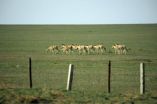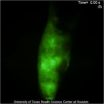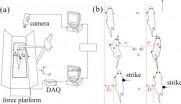(Press-News.org) Boulder, Colo., USA – In a new study published in the Geological Society of America Bulletin, geoscientists Wolfgang Stinnesbeck of the University of Heidelberg and colleagues document the discovery of forty-six ophthalmosaurid ichthyosaurs (marine reptiles). These specimens were discovered in the vicinity of the Tyndall Glacier in the Torres del Paine National Park of southern Chile. Among them are numerous articulated and virtually complete skeletons of adults, pregnant females, and juveniles.
Preservation is excellent and occasionally includes soft tissue and embryos. The skeletons are associated with ammonites, belemnites, inoceramid bivalves, and fishes as well as numerous plant remains. The enormous concentration of ichthyosaurs is unique for Chile and South America and places the Tyndall locality among the prime fossil Lagerstätten for Early Cretaceous marine reptiles worldwide.
Four different species have been identified. Both concentration and diversity of ichthyosaurs are unique for South America and place the Tyndall locality among the prime fossil Lagerstätten marine reptiles worldwide. The deposit is Early Cretaceous in age (about 146 million years ago) and forms part of a deep water sequence located in the Rocas Verdes Basin, a straight separating Antarctica and South America from Late Jurassic to late Early Cretaceous times.
The Tyndall ichthyosaurs were gregarious and likely hunted in packs in a submarine canyon near the east coast of this sea. Their potential prey, belemnites and small fishes, were abundant due to plankton blooms caused by cold water upwelling. Occasionally, high energy turbiditic mudflows sucked down everything in their reach, including ichthyosaurs. Inside the suspension flows, the air-breathing reptiles lost orientation and finally drowned. They were instantly buried in the abyss at the bottom of the canyon.
FEATURED ARTICLE
A Lower Cretaceous ichthyosaur graveyard in deep marine slope channel deposits at Torres del Paine National Park, Southern Chile
W. Stinnesbeck et al., Institut für Geowissenschaften, Ruprecht-Karls-Universität Heidelberg, Im Neuenheimer Feld 234-236, 69221 Heidelberg, Germany. Published online 22 May 2014; http://dx.doi.org/10.1130/B30964.1.
Highlights of other GSA Bulletin articles are provided below.
GSA BULLETIN articles published ahead of print are online at http://gsabulletin.gsapubs.org/content/early/recent; abstracts are open-access at http://gsabulletin.gsapubs.org/. Representatives of the media may obtain complimentary copies of articles by contacting Kea Giles.
Sign up for pre-issue publication e-alerts at http://www.gsapubs.org/cgi/alerts for first access to new journal content as it is posted. Subscribe to RSS feeds at http://gsabulletin.gsapubs.org/rss/.
Please discuss articles of interest with the authors before publishing stories on their work, and please make reference to GSA Bulletin in your articles or blog posts. Contact Kea Giles for additional information or assistance.
Non-media requests for articles may be directed to GSA Sales and Service, gsaservice@geosociety.org.
(U-Th)/He geochronology and chemical compositions of diagenetic cement, concretions, and fracture-filling oxide minerals in Mesozoic sandstones of the Colorado Plateau
P.W. Reiners et al., Department of Geosciences, Gould-Simpson Building, 1040 E. 4th Street, University of Arizona, Tucson, Arizona 85721, USA. Published online 22 May 2014; http://dx.doi.org/10.1130/B30983.1.
Water dissolving, and water removing--under the rocks and stones, there is water flowing underground. But is it the same as it ever was? In fact, the geologic record of secondary minerals left behind by ancient fluid flow through bedrock has the potential to record changes through time in the tectonics, landscape, and climate that influence groundwater and hydrocarbon flow. By analyzing the geochronologic ages and compositions of iron and manganese oxide cement, concretions, and fracture-fill in sandstones on the Colorado Plateau, Reiners et al. have shown that some of these diagenetic minerals formed as early as 25 million years ago, but continued to react with later groundwater until much more recently. Many concretions and other secondary oxides record ages suggesting fluid-rock reactions between about 2-3 million years ago, a time of both major climate and geomorphic changes in the region, and some fracture fill material suggests an episode of formation at 300 thousand years ago, possibly associated with a wave of rapid incision. Taken together these results show that diagenetic oxide minerals can record the timing of ancient fluid flow events, and could be used to understand past episodes of groundwater flow on Earth and other planets.
Postglacial denudation of western Tibetan Plateau margin outpaced by long-term exhumation
H. Munack et al., Institute of Earth and Environmental Sciences, Universität Potsdam, 14476 Potsdam, Germany. Published online 22 May 2014; http://dx.doi.org/B30979.1.
The Indus River, one of Asia's premier rivers, links the western Tibetan Plateau and the Nanga Parbat region of Kashmir. These two areas juxtapose some of the lowest and highest topographic relief and commensurate denudation rates in the high-elevated regions of Himalaya and Tibet, respectively. Yet it remains unclear how rapidly rivers incise into the seemingly long-lived Tibetan Plateau margin by removing material and migrating headwards into the arid plateau interior. We explore the regional denudation pattern across this western margin of the Roof of the World by combining independent radiometric dating, mineralogical analysis of river sands, and computational landscape analysis. Our data reveal a systematic decrease of landscape downwearing towards the Tibetan Plateau. Yet we find that the highest denudation rates occur >100 km below the most prominent knickpoint on the Indus River, where it drops off the Tibetan Plateau. From this observation we infer that any erosion attacking the interior of the plateau has mostly concerned reaches well below the plateau margin. Moreover, reported rock exhumation rates averaging over millions of years consistently exceed our millennial-scale estimates of postglacial denudation rates. To counterbalance this apparent mismatch, denudation rates must have been higher in the Quaternary during glacial-interglacial intervals.
Ontogeny of point bars on a river in a cold semi-arid climate
J.A. Moody and R.H. Meade, U.S. Geological Survey, 3215 Marine St., Suite E-127, Boulder, Colorado 80303, USA and U.S. Geological Survey, Box 25046, Denver Federal Center, Denver, Colorado 80225, USA. Published online 22 May 2014; http://dx.doi.org/10.1130/B30992.1.
Point bars are distinctive features of meandering rivers, appear to be persistent, but are transient in nature. Each has a history that includes birth, evolution, abandonment, and burial. We documented the ontogeny of new point bars that formed in cutoffs during the extreme flood of 1978 on Powder River in southeastern Montana. Ontogeny includes the evolution stage of the point bar but also the formation stage of the point-bar platform--the foundation of the point bar itself. Point-bar platforms were built by a random process of deposition and erosion during multiple floods each year. The number and magnitude of these floods characterizes the hydro-climatic regime. The random process gradually changed the original concave channel shape to a convex shape upon which the point bar could form and evolve. Convex surfaces reduce the likelihood that sediment would be eroded. However, erosion was found to be a significant process in determining the ultimate shape of the point bars. The characteristics of the point bars on Powder River were compared with those described on other rivers with different hydro-climatic regimes. We found that the sediment composition and the form of point-bar features depended on the nature of the hydro-climatic regime for each river.
A universal power-law scaling exponent for fracture apertures in sandstones
J.N. Hooker et al., Department of Earth Sciences, University of Oxford, South Parks Road, Oxford, Oxfordshire OX1 3AN, UK. Published online 22 May 2014; http://dx.doi.org/10.1130/B30945.1.
From the abstract: A high-resolution data set of kinematic aperture (opening displacement) of opening-mode fractures, from large (up to 2 m long) quartz-cemented sandstone samples, shows that microfractures are ubiquitous and that most natural-fracture sets are better fit by power-law size distributions than by exponential, normal, or log-normal distributions. The data set includes 3822 fractures within 68 scanlines from eight formations on three continents. Kinematic apertures were measured along scanlines using scanning electron microscope–based cathodoluminescence (SEM-CL) and, for field data, using a hand lens. Microtextural evidence from SEM-CL shows that power law–distributed fractures typically have crack-seal texture and are composed of opening increments having a narrow (characteristic) aperture size range. In contrast, rare non-power-law–distributed fracture populations lack crack-seal texture. Power-law exponents, as measured in one dimension, have values of -0.8 plus or minus 0.1. Most variation among fracture sets results from power-law coefficients, which constitute a scale-invariant measure of fracture intensity. We show how observed scaling patterns can be used to improve estimations of large-fracture spacing in cases where fracture sampling is limited, as by the width of cores. The low (less than 1) value of the power-law scaling exponent reflects but a gentle increase in fracture frequency with decreasing size, such that microfracture abundances in core are commonly too low for statistically robust sampling. On the other hand, the consistency of the scaling exponent among fracture sets within various tectonic settings is such that the exponent can be assumed, facilitating large-fracture spacing estimations. The assumption of the scaling exponent should be supported by the presence of crack-seal texture within fractures.
INFORMATION:
http://www.geosociety.org
New Ichthyosaur graveyard found
GSA Bulletin articles posted online May 22
2014-06-03
ELSE PRESS RELEASES FROM THIS DATE:
Miniature digital zenith telescope for astronomy and geoscience
2014-06-03
As a kind of ground-based optical astrometric instrument, zenith telescope observes stars near zenith, which substantially reduces the influence of normal atmospheric refraction. Its high-precision observations can be used to calculate astronomical latitude and longitude, which are mainly applied in mobile measurement for deflection of the vertical, long-term measurement for the variations of the vertical, and related researches of astronomical seismology. Utilizing CCD camera, high-precision tiltmeter and other new technologies and devices, Chinese researchers have successfully ...
Image release: A violent, complex scene of colliding galaxy clusters
2014-06-03
Astronomers using the Karl G. Jansky Very Large Array (VLA) and the Chandra X-Ray Observatory have produced a spectacular image revealing new details of violent collisions involving at least four clusters of galaxies. Combined with an earlier image from NASA's Hubble Space Telescope (HST), the new observations show a complex region more than 5 billion light-years from Earth where the collisions are triggering a host of phenomena that scientists still are working to understand.
The HST image forms the background of this composite, with the X-ray emission detected by Chandra ...
In utero exposure to antidepressants may influence autism risk
2014-06-03
PHILADELPHIA (June 2, 2014) – A new study from researchers at Drexel University adds evidence that using common antidepressant medications during pregnancy may contribute to a higher risk of autism spectrum disorders (ASD) in children, although this risk is still very small.
Results from past studies of prenatal use of selective serotonin reuptake inhibitors (SSRIs) and ASD risk have not been consistent. An ongoing challenge in this line of research is trying to tease apart potential effects of the medication on risk from the effects associated with the condition for ...
Breaking down barriers
2014-06-03
The Gobi-Steppe Ecosystem is world renowned for its populations of migratory ungulates, which cover great distances in search of forage. Researchers at the Research Institute of Wildlife Ecology at Vetmeduni Vienna have documented, that in just one year an individual wild ass can range over an area of 70,000 km2. "Wild asses and gazelles have to be permanently on the move and travel very long distances to find enough food. Rainfall is highly variable in this region. As a consequence pastures are patchy and unpredictable in space and time," explains Petra Kaczensky, one ...
Lasers and night-vision technology help improve imaging of hidden lymphatic system
2014-06-03
VIDEO:
This is a movie illustrating the lack of lymphatic flow in the lower leg of a subject with lymphedema.
Click here for more information.
WASHINGTON, June 3, 2014—The human lymphatic system is an important but poorly understood circulatory system consisting of tiny vessels spread throughout the body. This "drainage" network helps guard against infections and prevents swelling, which occasionally happens when disease or trauma interrupts normal lymphatic function. Chronic ...
Security guard industry lacks standards, training
2014-06-03
EAST LANSING, Mich. --- Despite playing a more important role in the wake of 9/11, the security guard industry remains plagued by inadequate training and standards in many states, indicates new research by Michigan State University criminologists.
Formal training of the nation's 1 million-plus private security officers is widely neglected, a surprising finding when contrasted with other private occupations such as paramedics, childcare workers and even cosmetologists, said Mahesh Nalla, lead investigator and MSU professor of criminal justice.
By and large, security ...
Balancing strategy to lateral impact in a rat Rattus norregicus
2014-06-03
The balancing strategy to lateral impact in a rat is closely related to the striked position of the body. The research result can be inspired to improve the robustness of bionic robot. This was found by Dr. JI Aihong and his group from Institute of Bio-inspired Structure and Surface Engineering, Nanjing University of Aeronautics and Astronautics. This work, entitled "Balancing strategy to lateral impact in a rat Rattus norregicus", was published in Chinese Science Bulletin (In Chinese),2014, Vol 59(13) issue.
The center of mass(COM) of animal's body always falls ...
Modeling and simulation in the big data era
2014-06-03
The big data era bring the confusions, challenges and opportunities to the modeling and simulation field tightly associated with big data. The Chinese Association for System Simulation undertook the 81st new ideas and new theories academic salon of China Association for Science and Technology. This salon, directed by Li Bohu (academician of Chinese Academy of Science) and Hu Xiaofeng (professor of National Defense University, PLA) as the leading scientists, called about 20 specialists and scholars from all the country together. They deeply investigated big data from different ...
Scientists uncover features of antibody-producing cells in people infected with HIV
2014-06-03
WHAT:
By analyzing the blood of almost 100 treated and untreated HIV-infected volunteers, a team of scientists has identified previously unknown characteristics of B cells in the context of HIV infection. B cells are the immune system cells that make antibodies to HIV and other pathogens. The findings augment the current understanding of how HIV disease develops and have implications for the timing of treatment. Researchers at the National Institute of Allergy and Infectious Diseases, part of the National Institutes of Health, led the study.
Using advanced tools to probe ...
The quest for the bionic arm
2014-06-03
ROSEMONT, Ill.—In the past 13 years, nearly 2,000 veterans returned from Iraq and Afghanistan with injuries requiring amputations; 14 percent of those injured veterans required upper extremity amputations. To treat veterans with upper extremity amputations, scientists continue to pursue research and development of bionic arms and hands with full motor and sensory function. An article appearing in the June issue of the Journal of the American Academy of Orthopaedic Surgeons (JAAOS) reviews the recent advancements in upper extremity bionics and the challenges that remain ...
LAST 30 PRESS RELEASES:
New study overturns long-held model of how plants coordinate immune responses.
New AI model predicts disease risk while you sleep
Scientists discover molecular ‘reshuffle’ and crack an 80-year-old conundrum
How stressors during pregnancy impact the developing fetal brain
Electrons lag behind the nucleus
From fungi to brain cells: one scientist's winding path reveals how epigenomics shapes neural destiny
Schizophrenia and osteoporosis share 195 genetic loci, highlighting unexpected biological bridges between brain and bone
Schizophrenia-linked genetic variant renders key brain receptor completely unresponsive to both natural and therapeutic compounds
Innovative review reveals overlooked complexity in cellular energy sensor's dual roles in Alzheimer's disease
Autism research reframed: Why heterogeneity is the data, not the noise
Brazil's genetic treasure trove: supercentenarians reveal secrets of extreme human longevity
The (metabolic) cost of life
CFRI special issue call for papers: New Frontiers in Sustainable Finance
HKU Engineering scholar demonstrates the smallest all-printed infrared photodetectors to date
Precision empowerment for brain "eavesdropping": CAS team develops triple-electrode integrated functional electrode for simultaneous monitoring of neural signals and chemical transmitters during sleep
Single-capillary endothelial dysfunction resolved by optoacoustic mesoscopy
HKU three research projects named among ‘Top 10 Innovation & Technology News in Hong Kong 2025’ showcasing excellence in research and technology transfer
NLRSeek: A reannotation-based pipeline for mining missing NLR genes in sequenced genomes
A strand and whole genome duplication–aware collinear gene identification tool
Light storage in light cages: A revolutionary approach to on-chip quantum memories
Point spread function decoupling in computational fluorescence microscopy
BacPhase: Long-insert paired-end sequencing for bin marker construction and genome phasing
GmWOX1 regulates the mediolateral polarity of compound leaves in soybean
ChargeFabrica: An open-source simulation tool that aims to accelerate search for high performance perovskite solar cells
High levels of ADAR overexpression induce abundant and stochastic off-target RNA editing in rice protoplasts
On-demand upgraded recycling of polyethylene and construction of sustainable multifunctional materials based on the "LEGO" strategy
New "Stomata in-sight" system allows scientists to watch plants breathe in real-time
Anorexia nervosa may result in long-term skeletal muscle impairment
Narrative-based performance reviews deemed fairest by employees
New insights reveal how advanced oxidation can tackle emerging water pollutants
[Press-News.org] New Ichthyosaur graveyard foundGSA Bulletin articles posted online May 22





